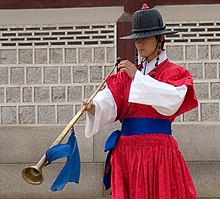String
Korean string instruments include those that are plucked, bowed, and struck. Most Korean string instruments use silk strings, except as noted.
Plucked
- Gayageum (hangul: 가야금; hanja: 伽倻琴) – A long zither with 12 strings; modern versions may have 13, 17, 18, 21, 22, or 25 strings
- Geomungo (hangul: 거문고; hanja: 玄琴) – A fretted bass zither with six strings that is plucked with a bamboo stick
- Daejaeng (hangul: 대쟁; hanja: 大筝) – A long zither with 15 strings, slightly larger than the gayageum; it was used during the Goryeo period but is no longer usedphoto
- Seul (hangul: 슬; hanja: 瑟) – A long zither with 25 strings, derived from the Chinese se; used today only in Munmyo jeryeak (Confucian ritual music)photo
- Geum (hangul: 금; hanja: 琴) – A 7-stringed zither, derived from the Chinese guqin; also called chilheyongeum; used today only in Munmyo jeryeak (Confucian ritual music)photo
- Gonghu (hangul: 공후; hanja: 箜篌) – Harps (no longer used). There were four subtypes according to shape:
- Sogonghu (hangul: 소공후; hanja: 小箜篌; literally "small harp") – harp with angled sound box, 13 strings, and a peg that is tucked into the player's beltphoto
- Sugonghu (hangul: 수공후; hanja: 豎箜篌; literally "vertical harp") – vertical harp without sound box and 21 stringsphoto
- Wagonghu (hangul: 와공후; hanja: 臥箜篌; literally "lying down harp") – Arched harp with a large internal sound box and 13 stringsphoto
- Daegonghu (hangul: 대공후; hanja: 大箜篌) – large vertical harp with 23-strings
- Bipa (hangul: 비파; hanja: 琵琶) – A pear-shaped lute with four or five strings (subtypes include the 5-stringed hyangbipa, which is also called jikgyeongbipa; and the 4-stringed dangbipa); derived from the Chinese pipa; no longer used
- Wolgeum (hangul: 월금; hanja: 月琴) – A lute with a moon-shaped wooden body, four strings, and 13 frets; no longer used
- Cheolhyeongeum (hangul: 철현금; hanja: 鐵絃琴) – A steel-stringed zither plucked with a stick and played with a slide in the manner of a slide guitar, developed in the 20th centuryphoto 1photo 2
- Ongnyugeum (hangul: 옥류금; hanja: 玉流琴) – A large modernized box zither with 33 nylon-wrapped metal strings, developed in North Korea in 1973; pronounced ongryugeum in North Koreaphoto 1photo 2photo 3
Bowed
- Haegeum (hangul: 해금; hanja: 奚琴) – A vertical fiddle with two strings
- Ajaeng (hangul: 아쟁; hanja: 牙箏) – A bowed zither, derived from the Chinese yazheng
- Sohaegeum (hangul: 소해금) – A modernized fiddle with four strings; used only in North Koreaphoto 1photo 2
[edit] Struck
- Yanggeum (hangul: 양금; hanja: 洋琴) – A hammered dulcimer with metal strings, struck with a bamboo stick
Wind
Flutes
- Daegeum (hangul: 대금; hanja: 大琴 or 大笒) – A large transverse bamboo flute with buzzing membrane
- Junggeum (hangul: 중금; hanja: 中琴 or 中笒) – A medium-sized transverse bamboo flute without buzzing membrane
- Sogeum (hangul: 소금; hanja: 小琴 or 小笒) – A small transverse bamboo flute without buzzing membrane
- Danso (hangul: 단소; hanja: 短簫) – A small notched vertical bamboo flute
- Tungso (hangul: 퉁소; hanja: 洞簫) – A long notched vertical bamboo flute; originally called tongso; derived from the Chinese dongxiao
- Yak (hangul: 약; hanja: 籥) – A notched vertical bamboo flute with three finger holes; used in Confucian ritual music and dance
- Ji (hangul: 지; hanja: 篪) – An ancient vertical bamboo flute with a protruding notched blowhole and five finger holes (one in the back and four in the front), used only in aak; derived from the Chinese chí
- Jeok (hangul: 적; hanja: 翟) – An ancient flute of Chinese origin; used in court ritual music
- So (hangul: 소; hanja: 簫) – A pan flute; derived from the Chinese paixiao; used only in Munmyo jeryeak (Confucian ritual music)
- Dangjeok (hangul: 당적; hanja: 唐笛) – A small transverse bamboo flute of Chinese origin, slightly smaller than the junggeum
- Hun (hangul: 훈; hanja: 塤) – A globular flute made of baked clay originating from the Chinese xun--end-blown like a shakuhachi making it not an ocarina (which is a whistle design.]]
Oboes
- Piri (hangul: 피리; hanja: 觱篥) – A cylindrical oboe with a bamboo body. There are four varieties of piri:
- Taepyeongso (hangul: 태평소; hanja: 太平簫; also called hojok) – A conical oboe with a wooden body and metal bell
Mouth organs
- Saenghwang (hangul: 생황; hanja: 笙簧) – A free reed mouth organ with 17 bamboo pipes; derived from the Chinese sheng
- U (hangul: 우; hanja: 竽) – A free reed mouth organ, large in size; derived from the Chinese yu; no longer used
- Hwa (hangul: 화; hanja: 和) – A free reed mouth organ with 13 bamboo pipes; derived from the Chinese he; no longer used
Horns
- Nabal (hangul: 나발; hanja: 喇叭) – Long metal trumpet
- Nagak (hangul: 나각; hanja: 螺角) – Sea shell horn; also called sora
Percussion
Chimes
- Jong (hangul: 종; hanja: 鐘) – A bronze bell
- Pyeonjong (hangul: 편종; hanja: 編鐘) – A set of 16 tuned bronze bells used in ancient court music; derived from the Chinese bianzhong
- Teukjong (hangul: 특종; hanja: 特鐘) – A single large bronze bell
- Pyeongyeong (hangul: 편경; hanja: 編磬) – A set of 16 tuned stone chimes used in ancient court music; derived from the Chinese bianqing
- Teukgyeong (hangul: 특경; hanja: 特磬) – A single large tuned stone chime
- Banghyang (hangul: 방향; hanja: 方響) – A metallophone with 16 tuned iron slabs; derived from the Chinese fangxiangphoto
- Ulla (hangul: 운라; hanja: 雲鑼 or 雲羅) – A set of ten small tuned gongs in a wooden frame; derived from the Chinese yunluophoto
===Drums===]
- Buk (hangul: 북) – A barrel drum used primarily in pansori, pungmul, and samulnori. The term buk is also used in Korean as a generic term to refer to any type of drum.
- Janggu or Janggo (hangul: 장구 or 장고; hanja: 杖鼓 or 長鼓) – A double-headed hourglass-shaped drum generally played with one stick and one hand
- Galgo (hangul: 갈고; hanja: 羯鼓) – Double-headed hourglass-shaped drum similar to the janggo but played with two sticks and thinner drum heads; sometimes called yanggo or yangjanggo; no longer commonly used[1]
- Jingo (hangul: 진고; : 晉鼓) – Largest barrel drum
- Jeolgo (hangul: 절고; hanja: 節鼓) – Barrel drum
- Jwago (hangul: 좌고; hanja: 座鼓) – A barrel drum in a wooden frame
- Geongo (hangul: 건고; hanja: 建鼓) – Huge barrel drum
- Yonggo (hangul: 용고; hanja: 龍鼓) – A barrel drum with a dragon painted on its shell; used in daechwita
- Eunggo (hangul: 응고; hanja: 應鼓) – Barrel drum suspended from a frame
- Sakgo – (hangul: 삭고; hanja: 朔鼓) – A long barrel drum suspended from a wooden frame
- Gyobanggo (hangul: 교방고; hanja: 敎坊鼓) – Flat drum suspended from a frame
- Junggo (hangul: 중고; hanja: 中鼓) – Flat drum suspended from a frame; similar to the gyobanggo but larger
- Sogo (hangul: 소고; hanja: 小鼓) – A small hand-held drum
- Nogo (hangul: 노고; hanja: 路鼓) – A set of two drums pierced by a pole
- Nodo (hangul: 노도; hanja: 路鼗) – A set of two small drums on a pole, which is twisted to play; used in ritual music
- Yeongdo (hangul: 노도; hanja:靈鼗) – Four drums on a pole, which is twisted to play; used in ritual music
- Noedo (hangul: 뇌도; hanja: 雷鼗)) – six small drums hung in a frame; used in ritual music
- Noego (hangul: 뇌고; hanja: 雷鼓) – Three small barrel drums on a pole, which is twisted to play; used in ritual music
- Do (도) – single pellet drum on a pole
Gongs
- Kkwaenggwari (hangul: 꽹과리) – A small gong used primarily in folk music
- Jing (hangul: 징; hanja: 鉦) – A large gong; originally pronounced jeong (정)
Cymbals
- Jabara (hangul: 자바라; also called bara, bal, or jegeum) – pair of large brass cymbals
Other
- Bak (hangul: 박; hanja: 拍) – A wooden clapper used in ancient court and ritual music
- Bu (hangul: 부; hanja: 缶) – A clay pot used in Confucian ritual music; derived from the Chinese fǒu
- Chuk (hangul: 축; hanja: 柷) – A wooden box, played by hitting a stick on the inside, used to mark beats or sections; derived from the Chinese zhù; used in ancient ritual music
- Eo (hangul: 어; hanja: 敔) – A wooden percussion instrument carved in the shape of a tiger with a serrated back, played by running a bamboo whisk across it to mark the ends of sections; derived from the Chinese yǔ









 Print this page
Print this page


0 komentar:
Posting Komentar